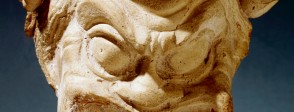Begin by exploring the mask. Identify the features and wreath and its exaggerated appearance and consider what it seems to be made of. It is quite readily recognisable as a mask, but giving the size will make it clear that it could never have been worn. Move on to looking at the flask in the form of an actor in For the classroom. Do the students think this character was meant to be funny? What other aspects of the figurine might contribute to a sense of the humorous? What do these two objects tell us about the popularity of theatre in the Greek world?
Look at the two tragic masks in For the classroom and compare them with the comic ones you have discussed. From here you can introduce the two main sorts of Greek play. Find suitable short video excerpts from a modern TV comedy and tragedy/serious drama. Discuss with the students what makes one funny and the other serious; look at styles of acting, types of language, subject matter, costumes if relevant, the things the actors do.
Once you have analysed modern examples of comic and serious drama, select one of the comic scenes and one of the tragic scenes in A bigger picture. Ask which the students think is the comedy and which the tragedy and why. Examine them closely and pick out everything that is going on and compare with their analysis of the modern examples.
Look at the two comic scenes from pots in A bigger picture, Identify as many elements as you can: the masks, the humorous costumes, the actions of the actors. Discuss what might actually be going on in the scenes – remember they are meant to be funny. Create tableaux in three stages: the moment before the scene shown, the scene shown and the moment after. You could then write scripts for the two scenes and act them out.
An important feature of tragedies and comedies was the chorus – a group of 12-15 masked actors who, while being characters from the story, used songs and dances to react to or comment on the action. Look at the wine jug in A bigger picture – identify the chorus members and notice how they are dressed as birds. Discuss whether they are meant to be funny – there was a comedy called Birds written by Aristophanes, but this jug is too early to show it. Notice the flute player on the left. Practise some choral readings of poems, perhaps using different chorus members for different lines and some lines spoken all together. Discuss what the experience is like for the actors and the audience. Try adding masks, music and movement.
Use the interactive activity in For the classroom to explore the layout and different parts of a Greek theatre. Use the list of Greek theatres in For the classroom and ask pairs of students to choose one to analyse and research. They could label their photos and you could create a map of Greek theatres around the Mediterranean region.
Discuss the differences between going to the theatre nowadays and in ancient Greece. Consider what it would be like seeing a play in broad daylight and the effect of the performance being part of a festival for a god. What impact would it have that plays were only performed a few times a year? Discuss the ceremonies that took place before the performances at the City Dionysia and what they were intended to communicate. Remind students that theatre was a communal experience – you would know many of the people in the audience, you would all be sitting together in the daylight and could see each other across the auditorium.
Use the interactive game in For the classroom to match different gods with different festivals. Use other sections of the same website to find out about the Olympic Games and compare them with the City Dionysia: who could take part, religious aspects, competition.
There are many ways in which you can explore the effect of masking on voice, movement, posture and how this impacts upon audience reaction. Drama colleagues will have experience and activities for this. Try acting out an emotional excerpt from a play with and without masks and discuss the differences. Object file: a Mesolithic headdress on this website has examples of masks from different cultures and periods.


